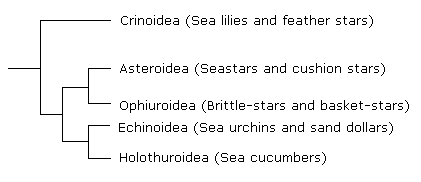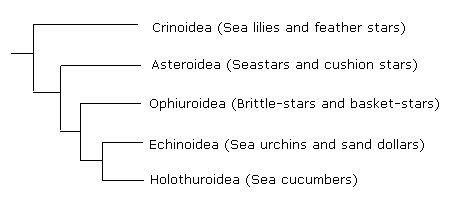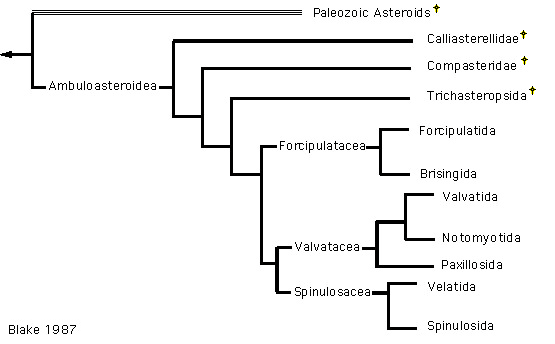
|
|
Domain - Eukarya |
The domain of eukarya consists of organisms that have cells with a membrane-bound nucleus and organelles.
|
|
Kingdom - Animalia |
The kingdom animalia contains organisms that are heterotrophic, multicellular, motile, and do not have cell walls or chloroplasts.
|
|
Phylum - Echinodermata |
The phylum echinodermata includes organisms that are triploblastic, have a coelom, bilateral symmetry as larvae, pentaradial symmetry as adults, and a water vascular system.
|
|
Class - Asteroidea |
The class asteroidea consists of organisms known commonly as seastars and cushion stars. These are organisms with a central disc and usually five arms (there are a few species which have more). A madreporite, anus, and spiny epidermal layer are located on the dorsal side. A network of tube feet and a mouth are located on the ventral side of these organisms.
|
|
Order - Forcipulatida |
The order forcipulatida contains asteroids with forcipulate pedicellariae which are a very distinguishable type of spine.
|
|
Family - Asteriidae |
The asteriidae family is distinguished by inconspicuous marginal plates, tube feet in rows of four, crossed pedicellariae, and spines on the dorsal side that are usually single.
|
|
Genus - Asterias |
The genus Asterias is characterized by the dorsal side having separate spines, the ambulacral spines alternate one and two, most spines carry pedicellariae, and the dorsal side is flexible with a delicate internal skeleton.
|
|
Species - Asterias rubens |
Asterias rubens can grow up to 600 mm in diameter, but it is not uncommon for an individual to be over 300 mm. It can be found in hues of reddish brown, orange, and violet with slightly lighter colored spines.
|
|
Asterias rubens and the Enchinodermata classes |
The class asteroidea (sea stars and cushion stars) is closely related to the class ophiuroidea (brittle-stars and basket-stars). However, their evolutionary relationships are still under debate. It is not certain whether these two classes share a monophyletic or polyphyletic relationship.
| Asterozoan Hypothesis |
 |
| Cryptosyringid Hypothesis |
 |
|
|
Asterias rubens and the Asteroidea orders |
Phylogenetic studies of the relationships between asteroids is very recent. Studies were not conducted until the late 1980's and as a result, there are not any definite answers to the relationships between the orders yet. However, it is currently widely believed that the forcipulatida order (the one that Asterias rubens belongs to) is closely related to the brisingida order. The brisingida order consists of deep-sea-dwelling asteroids which usually have 6-16 long arms that are used for suspension feeding.

Photo courtesy of Emily Knott at http://www.tolweb.org/Asteroidea/19238 from Blake's hypothesis (1987)
Send questions or comments to richards.mic2@students.uwlax.edu